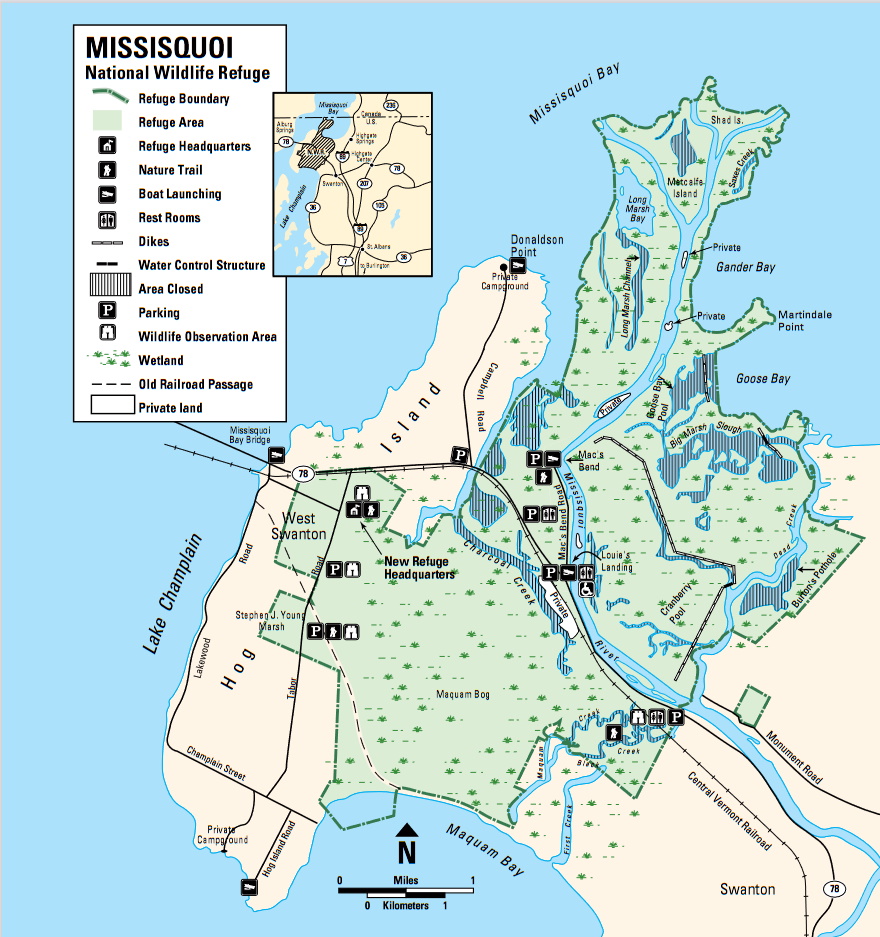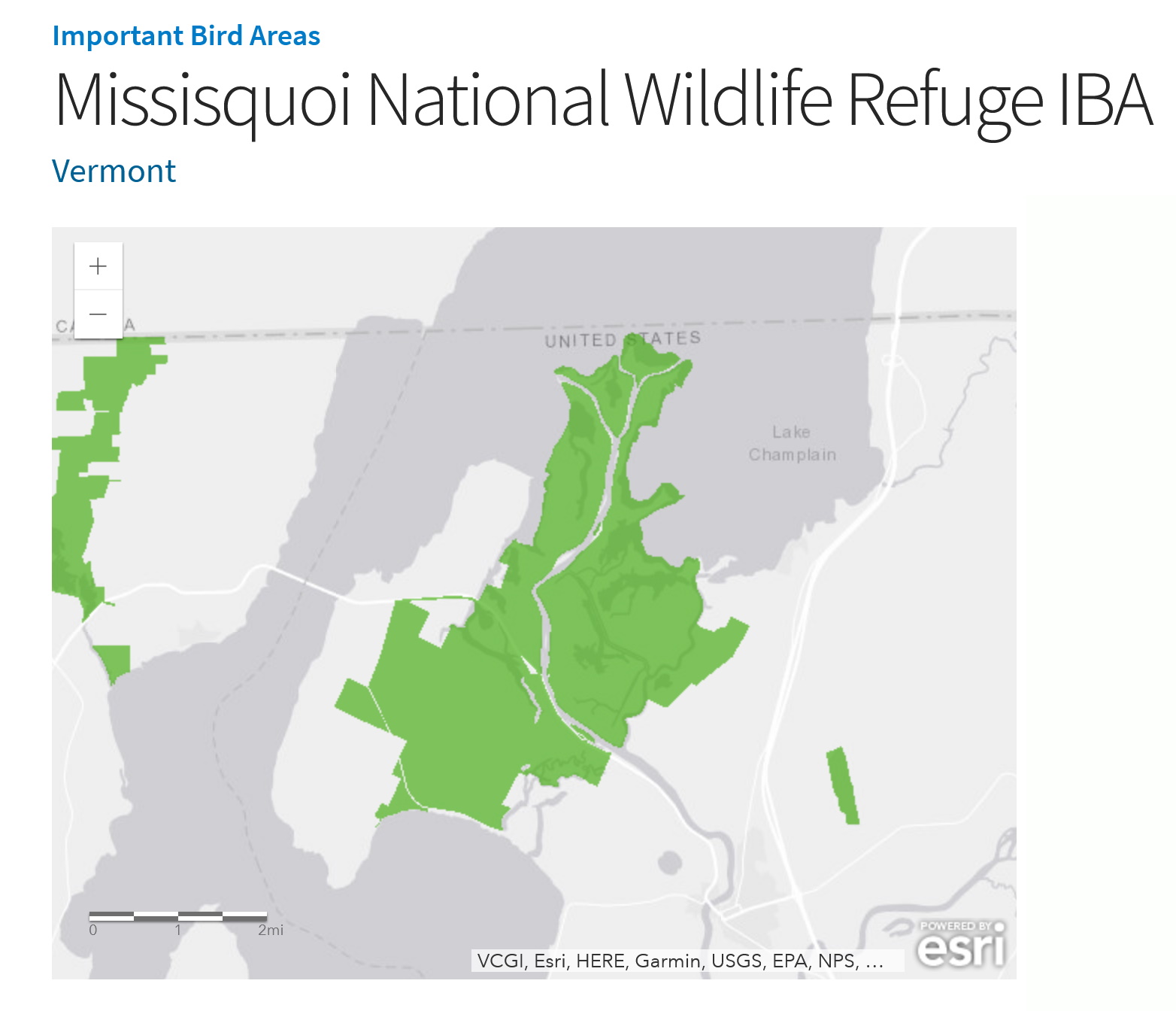Missisquoi NWR IBA
Missisquoi NWR IBA
Swanton, Vermont 05488
Missisquoi National Wildlife Refuge Official WebsiteMissisquoi National Wildlife Refuge map
Missisquoi National Wildlife Refuge (Audubon IBA) webpage
Tips for Birding
The general hotspot for the refuge and IBA covers a large area. Whenever possible, it is better to submit checklists that record more specifically where the birds were located.
Missisquoi National Wildlife Refuge is a birding gem hidden in plain sight in northwestern Franklin County. If you’ve ever traveled Route 78 west of Swanton, you’ve probably noticed the signs for the refuge, but its full extent isn’t at all obvious just driving through. The refuge has over 6700 acres that include most of the Missisquoi River delta, plus large grassland areas, hardwood forests, and a large bog.
Established in 1943, the refuge’s main mission is to provide stopover habitat for migrating waterfowl. However, the refuge also hosts a large Great Blue Heron rookery, the largest Black Tern population in Vermont, and nearly a third of the nesting Ospreys in Vermont (over 30 active nests in 2009). Wood Ducks are plentiful throughout the refuge, and the grasslands on Tabor Road host the largest Bobolink population in Vermont.
While most of the refuge is closed to the public for the protection of sensitive species, five trails covering diverse habitats are available to visitors. In addition to walking trails, canoeing and kayaking opportunities are available on the Missisquoi River, Dead Creek, and Charcoal Creek. Also, be aware that parts of the refuge are open to hunting and some trails may be closed during hunting season.
Directions: From I-89, take Exit 21 and turn west on Route 78. Follow Route 78 as it winds through Swanton village. After leaving the village, continue about 2.5 miles, still on Route 78, until you reach the first signs for the refuge.
Birds of Interest
Missisquoi’s size and location on Lake Champlain make it an ideal migratory stopover for a number of waterfowl species including Black Duck, Mallard, Ring-necked Duck, and Wood Duck. Breeding species include all of the above (with the exception of Ring-necked Duck) as well as Green and Blue-winged teal, Hooded Merganser, and Common Goldeneye. More than a third of the state-endangered Osprey population breeds here as well as the entire population of state-threatened Black Tern. Missisquoi is also home to the largest Great Blue Heron colony in the state. Virginia Rail, Common Moorhen, Sora, and Pied-billed Grebe can also be found in the refuge’s extensive marshes.
About Missisquoi National Wildlife Refuge
See all hotspots at Missisquoi National Wildlife Refuge
About Missisquoi National Wildlife Refuge
The Missisquoi National Wildlife Refuge was established in 1943 to provide a habitat for migratory birds. It consists of 6,729 acres, mostly wetland habitats, which support a variety of migratory birds and other wildlife. The 900-acre Maquam bog is designated as a Research Natural Area and the refuge was designated as an Important Bird Area in partnership with the Audubon Society. The Refuge in partnership with other publicly owned (State of Vermont) lands has been designated a Wetland of International Importance under the Ramsar Convention. A mosaic of wetland habitats offers opportunities to see and manage more than 200 species of birds. Fall migration features 20,000-25,000 migrating ducks. Nesting bald eagles, osprey, and a great blue heron colony numbering more than 300 nests are present on the refuge. Please note that most public use is permitted only on designated trails or along the Missisquoi River. Please consult the refuge office for areas that are closed to public use to protect sensitive wildlife and habitat.
About Missisquoi National Wildlife Refuge Important Bird Area
Missisquoi National Wildlife Refuge is located in Swanton where the Missisquoi River joins Lake Champlain, forming one of the largest wetland complexes in the state. Missisquoi combines extensive bottomland and grassland habitat with a number of wetland community types. Management practices such as the creation of impoundments have provided critical habitat for breeding and migrating waterfowl as well as a number of state-listed species. Vermont Natural Community types include Lakeside Floodplain Forest, Red or Silver Maple-Green Ash Swamp, Cattail, Deep Broadleaf, and Deep Bulrush marshes, Buttonbush Swamp, and Pitch Pine Woodland Bog.
Missisquoi is owned and managed by the federal government. Annual monitoring of waterfowl, Osprey, Black Tern, marshbirds, and grassland birds is ongoing. Conservation issues include invasive species such as purple loosestrife, Eurasian milfoil, and zebra mussels as well as agricultural run-off from farms upstream. A new headquarters is planned for the coming years.
Notable Trails
The Missisquoi Refuge offers some excellent trails for walking, snowshoeing, and cross-country skiing.
Features
Restrooms on site
Wheelchair accessible trail
Entrance fee
Content from Missisquoi National Wildlife Refuge Official Website, Missisquoi National Wildlife Refuge (Audubon IBA) webpage, http//friendsofmissisquoi.org/visit/trails/Friends of Missisquoi NWR website, and Ken Copenhaven, Green Mountain Audubon
Last updated October 17, 2023

